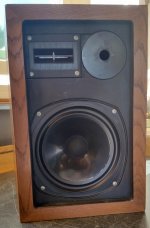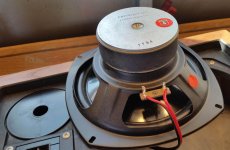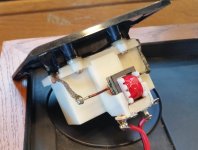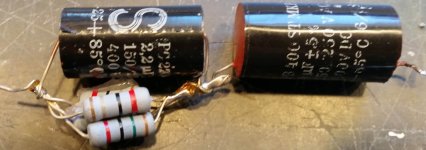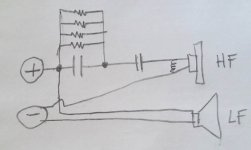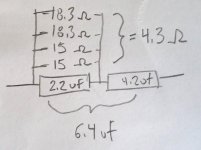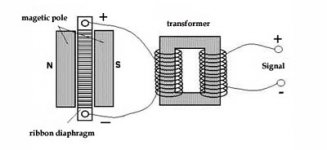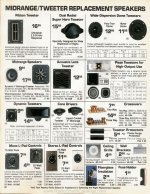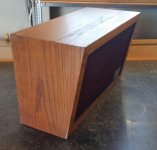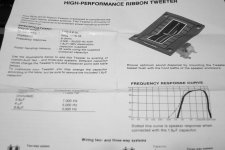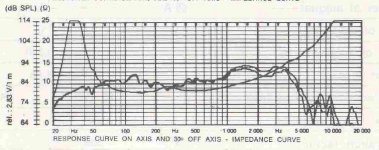Kenleigh Focused Field Monitors. I bought them thinking they'd have a great midrange and top end based on the ribbon tweeter in a small horn, but there is no real presence, no crisp top end. Even my wife says "muddy"
Dimensions 16 wide by 10 tall, about 8 deep on top tapering to 6 deep on the bottom. Low frequency is an 8 inch French Polydax HD20B25VHV marked 8 ohm and stamped 1184, presumed to be the production date. High frequency is an unmarked ribbon horn measuring 4 1/4 wide by 3 inches tall. Woofer shows 7.2 ohms resistance, tweeter shows .3 ohms resistance. No specs known or found about these drivers.
Woofer is direct connected. Path to the tweeter goes through 2 poly caps, the first cap in parallel with 4 resistors. First cap is marked 2.2uf and measures 2.17, second caps is marked 4uf and measures 4.2uf. Two caps in series measures 6.4uf.
The resistors have me stumped, and I have never seem them used this way before if a crossover. Why 4 in parallel and not one single? Are these referred to a shunt resistors to drop impedance?
Resistors are 2 watts. I know how to read resistors: Two resistors are Red Black Green Gold which means 2 meg ohm 5% but they measure 15 ohm. Other 2 resistors are Red Black Orange Gold which means 20K ohm 5% but they measure 18.3 ohms. Calculating resistors in parallel, and reading the color stripes, I should come up with 9.9K. Measuring the resistors in parallel, I get 4.2 ohms.
Question Number One: What am I not understanding about resistors here?
Question Number Two: What do I change to recover top end and get these out of the audio mud? Is there anything special about as ribbon tweeter versus a dome when it come to crossovers? Can I just replace what I have with a 2nd order 12db LR? What frequency do I crossover at?
Thanks!
Dimensions 16 wide by 10 tall, about 8 deep on top tapering to 6 deep on the bottom. Low frequency is an 8 inch French Polydax HD20B25VHV marked 8 ohm and stamped 1184, presumed to be the production date. High frequency is an unmarked ribbon horn measuring 4 1/4 wide by 3 inches tall. Woofer shows 7.2 ohms resistance, tweeter shows .3 ohms resistance. No specs known or found about these drivers.
Woofer is direct connected. Path to the tweeter goes through 2 poly caps, the first cap in parallel with 4 resistors. First cap is marked 2.2uf and measures 2.17, second caps is marked 4uf and measures 4.2uf. Two caps in series measures 6.4uf.
The resistors have me stumped, and I have never seem them used this way before if a crossover. Why 4 in parallel and not one single? Are these referred to a shunt resistors to drop impedance?
Resistors are 2 watts. I know how to read resistors: Two resistors are Red Black Green Gold which means 2 meg ohm 5% but they measure 15 ohm. Other 2 resistors are Red Black Orange Gold which means 20K ohm 5% but they measure 18.3 ohms. Calculating resistors in parallel, and reading the color stripes, I should come up with 9.9K. Measuring the resistors in parallel, I get 4.2 ohms.
Question Number One: What am I not understanding about resistors here?
Question Number Two: What do I change to recover top end and get these out of the audio mud? Is there anything special about as ribbon tweeter versus a dome when it come to crossovers? Can I just replace what I have with a 2nd order 12db LR? What frequency do I crossover at?
Thanks!
Attachments
Last edited:
For the resistors, I think your reading them backwards.
With time the colours can change, so the gold may actually be brown.
This would line up with what your measuring.
So your Red Black Green Gold becomes, brown green black red. 1 5 0 (multi) red (tolerance) = 15 Ohms.
These days I find colour coding not very clear. Primarily due to thin bands with 'washy' colour saturation.
Not helped by the bands now being (mostly) evenly spaced rather than grouped with a clear obvious space to the tolerance band of olden days.
edit.
too me the resistors body being a blueish colour suggests metal film, which also lines up with 2% tolerance.
With time the colours can change, so the gold may actually be brown.
This would line up with what your measuring.
So your Red Black Green Gold becomes, brown green black red. 1 5 0 (multi) red (tolerance) = 15 Ohms.
These days I find colour coding not very clear. Primarily due to thin bands with 'washy' colour saturation.
Not helped by the bands now being (mostly) evenly spaced rather than grouped with a clear obvious space to the tolerance band of olden days.
edit.
too me the resistors body being a blueish colour suggests metal film, which also lines up with 2% tolerance.
Last edited:
Maybe I am an idiot? Maybe not, but what a doofus! I have read carbon resistors for ages and always saw gold as the last band for 5%. If I reverse them, you are right Brown Green Red Black = 15 ohms (measured 15) and the others must be Brown Grey Black Red = 18 ohms (measured 18.3). Thanks for pointing that out...
But why four in parallel instead of one?
Next question still stands: What do I change to recover top end and get these out of the audio mud? Is there anything special about as ribbon tweeter versus a dome when it come to crossovers? Can I just replace what I have with a 2nd order 12db LR? What frequency do I crossover at?
But why four in parallel instead of one?
Next question still stands: What do I change to recover top end and get these out of the audio mud? Is there anything special about as ribbon tweeter versus a dome when it come to crossovers? Can I just replace what I have with a 2nd order 12db LR? What frequency do I crossover at?
No your not a doofus.
Just caught out by the lack of companies not sticking with the standards recommendations.
If it wasn't for DMM's these days I'd be up the proverbial re color coding on resistors.
Even with 'work bench' glasses and magnifying lamps and good lighting, it's still close to a guessing game these days.
Four instead of one will be to increase power handling.
And I do know of some that think multiple smaller metal films are better than a single 10w.
I won't go into that rabbit hole
You said your ribbon measures as 0.3 ohm.
So unless you want to kill any amplifier connected to it you will have to include a series resistor (4+ ohms) irrespective of whatever crossover you use.
Why has it lost it's output ?
I'm betting the actual ribbons (foil element) are gone.
All you've measured is the transformer on it.
That won't tell you what the actual ribbon element is like.
Just caught out by the lack of companies not sticking with the standards recommendations.
If it wasn't for DMM's these days I'd be up the proverbial re color coding on resistors.
Even with 'work bench' glasses and magnifying lamps and good lighting, it's still close to a guessing game these days.
Four instead of one will be to increase power handling.
And I do know of some that think multiple smaller metal films are better than a single 10w.
I won't go into that rabbit hole
You said your ribbon measures as 0.3 ohm.
So unless you want to kill any amplifier connected to it you will have to include a series resistor (4+ ohms) irrespective of whatever crossover you use.
Why has it lost it's output ?
I'm betting the actual ribbons (foil element) are gone.
All you've measured is the transformer on it.
That won't tell you what the actual ribbon element is like.
Last edited:
If you can measure the resistance of the ribbon itself, it should be around 1 to 3 ohm. If it reads open circuit then, unfortunately, there is a break in the ribbon.
Sometimes, it is possible to bridge the break with conductive paint - search the interweb for how you might do this.
Sometimes, it is possible to bridge the break with conductive paint - search the interweb for how you might do this.
Old'n'Cranky: With a handle like that, I'll guess you began working on hot chassis since the All American Five days!
Per your note on a series resistor, I posted approximately the same thing on Audiokarma, and a guy from the UK said What this circuit will do is to initially give a highpass filter of 3600Hz with the 4.3ohm resistance acting as an attenuator in series with the 4.2uF cap. The 2.2uF cap will effectively be open circuit at this point, until at about 6000Hz when the 2.2uF cap starts to conduct, gradually bypassing the resistors. Therefore, what you have is a dual slope highpass filter for the tweeter which has a low level (attenuated) output between 3600Hz and 6000Hz with increasing output above that point.
The ribbons do put out audio, I disconnected the ribbon entirely, and connected a small 2 watt amp (pulled from a small Bluetooth box running at 5V) to them, and I did get Joe Morello's cymbals on Take Five, albeit at a low volume.
Next, I will desolder the inductor in parallel with the ribbon and test the ribbon itself. (Is the inductor a "shunt coil" for impedance, not that I truly understand that...)
The search for a better top end continues.
Continued thanks for all the help!
Per your note on a series resistor, I posted approximately the same thing on Audiokarma, and a guy from the UK said What this circuit will do is to initially give a highpass filter of 3600Hz with the 4.3ohm resistance acting as an attenuator in series with the 4.2uF cap. The 2.2uF cap will effectively be open circuit at this point, until at about 6000Hz when the 2.2uF cap starts to conduct, gradually bypassing the resistors. Therefore, what you have is a dual slope highpass filter for the tweeter which has a low level (attenuated) output between 3600Hz and 6000Hz with increasing output above that point.
The ribbons do put out audio, I disconnected the ribbon entirely, and connected a small 2 watt amp (pulled from a small Bluetooth box running at 5V) to them, and I did get Joe Morello's cymbals on Take Five, albeit at a low volume.
Next, I will desolder the inductor in parallel with the ribbon and test the ribbon itself. (Is the inductor a "shunt coil" for impedance, not that I truly understand that...)
The search for a better top end continues.
Continued thanks for all the help!
I'm not clear what is going on here:
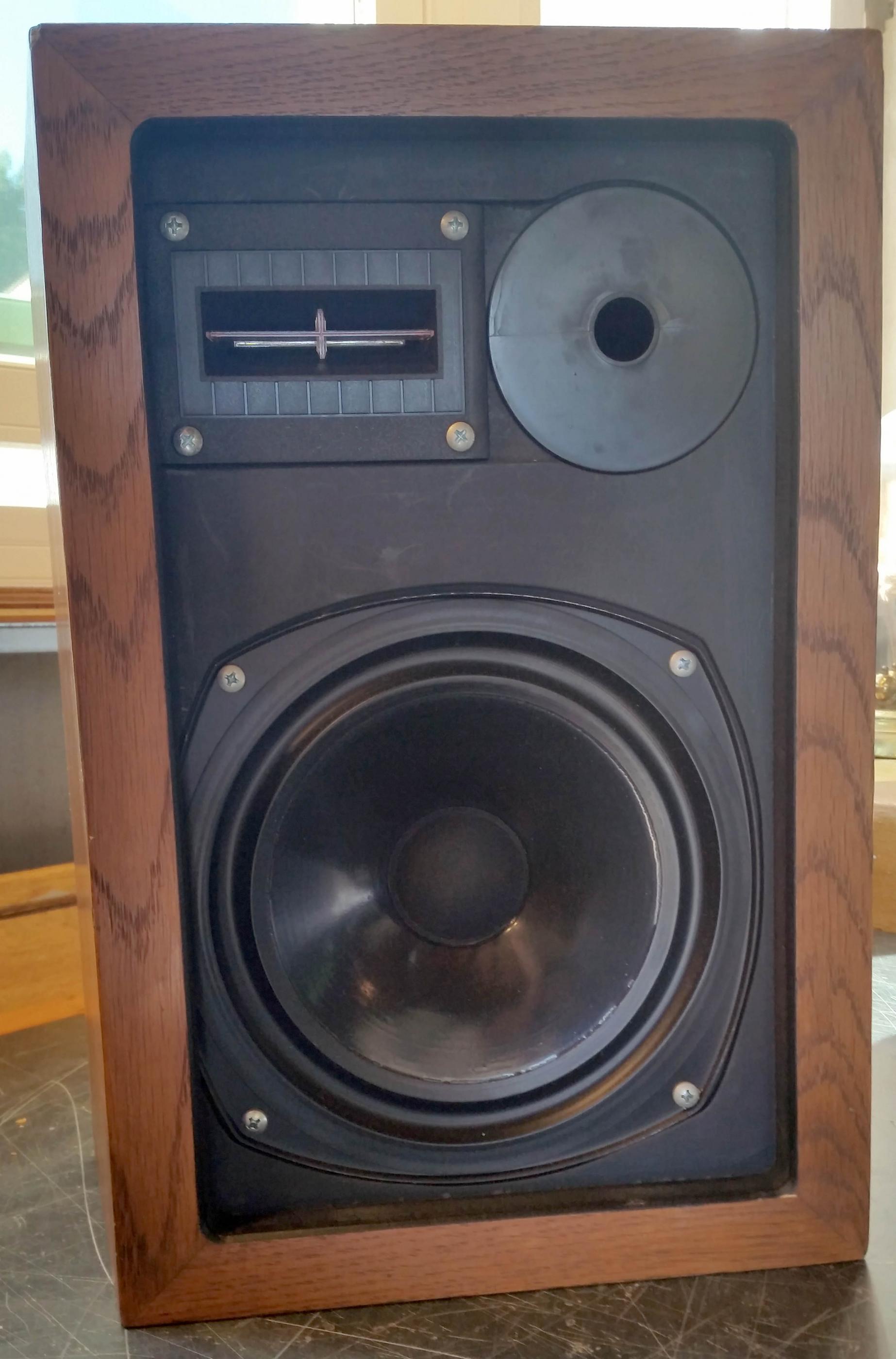
What is this? A small 5" bass speaker? Is that bass paper or plastic?
This is rudimentary to the max, bass running without crossover, guess just a glorified 4.2uF to the tweeter:
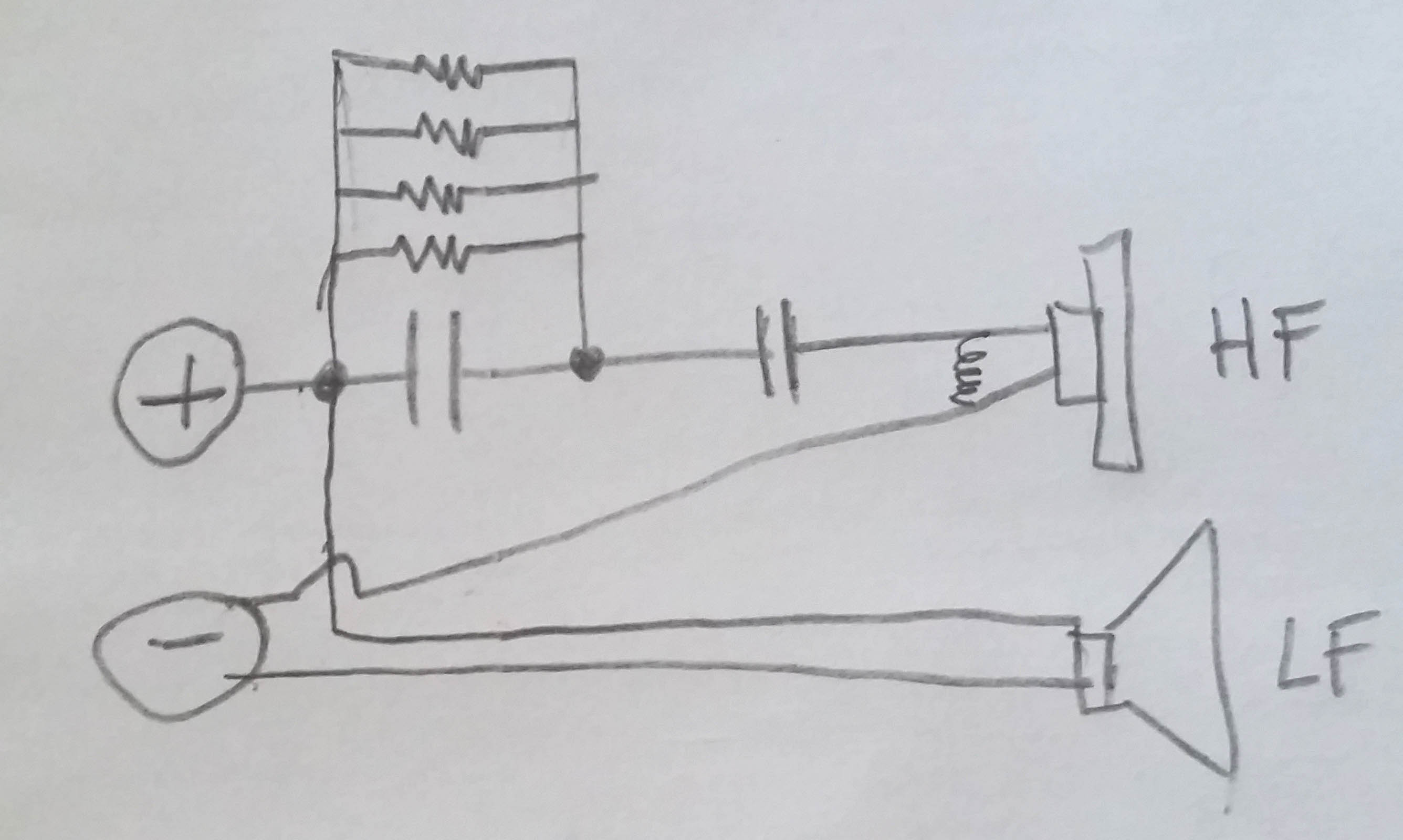
This ribbon or magnetodynamic tweeter has an input transformer:
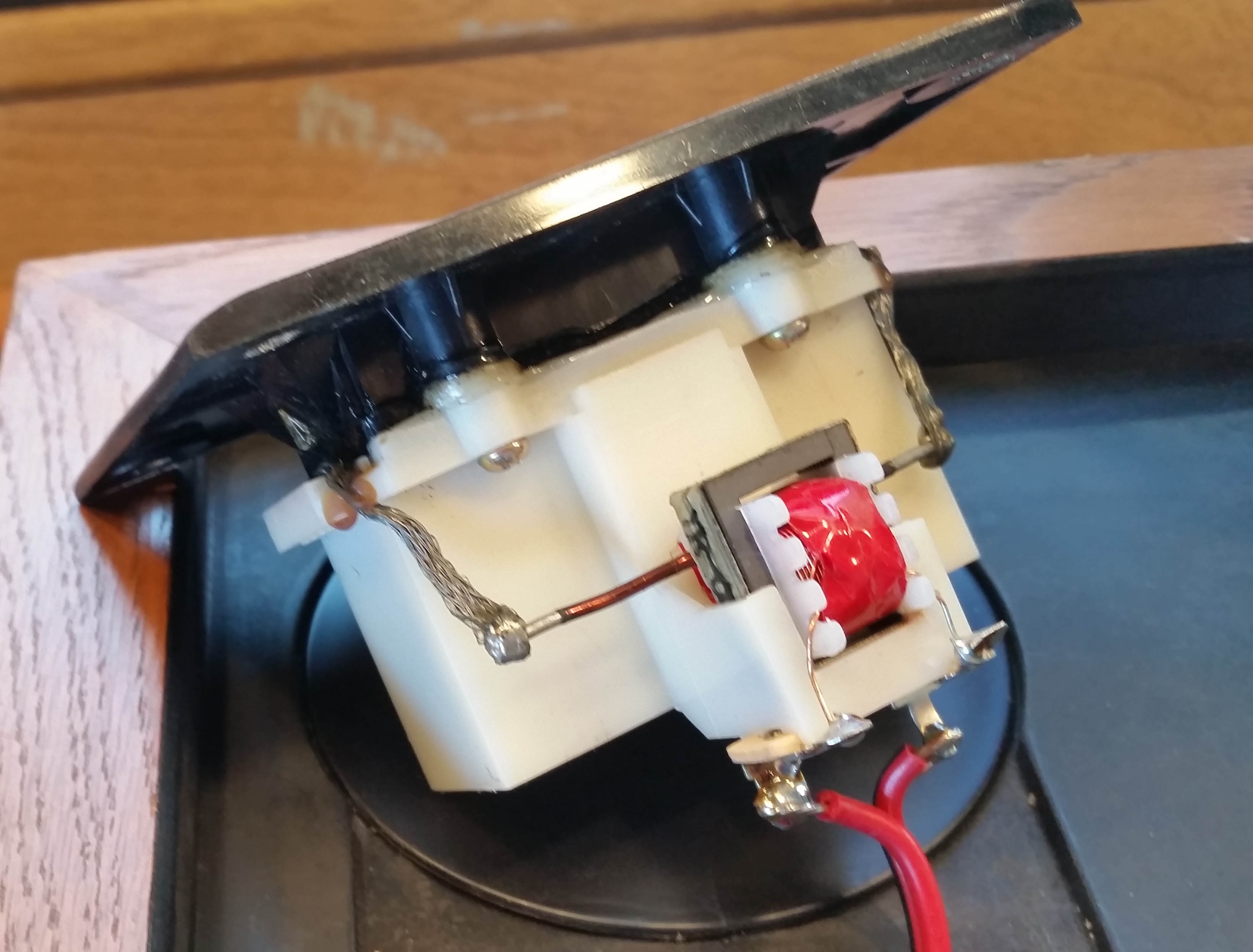
It's probably very fragile to low frequencies. I wouldn't even test it without a series capacitor around 2.2uF.
What is that round plate? Some sort of small port? There's probably the makings of a goodish small speaker there. Maybe replace the ribbon, maybe build a decent crossover. All been done before. Right now you are just poking around aimlessly.
What is this? A small 5" bass speaker? Is that bass paper or plastic?
This is rudimentary to the max, bass running without crossover, guess just a glorified 4.2uF to the tweeter:
This ribbon or magnetodynamic tweeter has an input transformer:
It's probably very fragile to low frequencies. I wouldn't even test it without a series capacitor around 2.2uF.
What is that round plate? Some sort of small port? There's probably the makings of a goodish small speaker there. Maybe replace the ribbon, maybe build a decent crossover. All been done before. Right now you are just poking around aimlessly.
As has been pointed out by Steve and Old'n'Cranky, that 'inductor' is a transformer. The crossover connects to one side of the transformer and the ribbon connects to the other side of the transformer.Next, I will desolder the inductor in parallel with the ribbon and test the ribbon itself. (Is the inductor a "shunt coil" for impedance, not that I truly understand that...)
Attachments
That "ribbon" is really not a ribbon. That tweeter used to be sold by Radio Shack years ago. It is actually a rigid embossed foil strip, sort of like a ribbon, BUT the strip of stiff foil is suspended all around the foil strip by a soft rubbery film material.
I have disected that ribbon , and I have some in use experience with it.
first- its not much good below about 4 k hz so I suspect the crossover may be in this area.
2nd- the 4-6 khz area is an area critical to that "presents" and "crisp" sound your looking for. So if crossed over in this area, the frequency response may have not been handled well here and there may be a large dip in response through the "presents" region.
3rd- The low resistance you are measuring on the ribbon is the DC resistance of the ribbons transformer primary winding. The actual tweeter impedance will be around 8 ohms. so its fine.
4th- This is a very RUGGED "ribbon". I wouldnt worry about burning this one up. The foil is thick and the structure is not a loose fragile foil but a rigidly suspended stiff thick foil strip.
In the end its impossible to tell whats going on here without measuring the freq response of speaker. BUT I suspect the tweeters output is not filling in well in the crossover region.
You may want to consider replacing the ribbon with a real one or a decent dome tweeter. Then have those here help you with a crossover for the whole thing that will get that crossover down around 2-3 Khz.
BTW just as a test I would try changing the polarity of the tweeters. Just a last resort kinda thing. Maybe the crossover is OK BUT there could be a dip in response due to a polarity issue?? Long shot here...
Lastly I would take that 2.2 uf cap And all the resistors in parallel with it and remove them. Just run the 4.2 uf cap. Then listen at lower volumes and see if the sound is more acceptable. That resistor /cap section may be pulling the low end sensitivity down enough to darken the 4 Khz region.
I have disected that ribbon , and I have some in use experience with it.
first- its not much good below about 4 k hz so I suspect the crossover may be in this area.
2nd- the 4-6 khz area is an area critical to that "presents" and "crisp" sound your looking for. So if crossed over in this area, the frequency response may have not been handled well here and there may be a large dip in response through the "presents" region.
3rd- The low resistance you are measuring on the ribbon is the DC resistance of the ribbons transformer primary winding. The actual tweeter impedance will be around 8 ohms. so its fine.
4th- This is a very RUGGED "ribbon". I wouldnt worry about burning this one up. The foil is thick and the structure is not a loose fragile foil but a rigidly suspended stiff thick foil strip.
In the end its impossible to tell whats going on here without measuring the freq response of speaker. BUT I suspect the tweeters output is not filling in well in the crossover region.
You may want to consider replacing the ribbon with a real one or a decent dome tweeter. Then have those here help you with a crossover for the whole thing that will get that crossover down around 2-3 Khz.
BTW just as a test I would try changing the polarity of the tweeters. Just a last resort kinda thing. Maybe the crossover is OK BUT there could be a dip in response due to a polarity issue?? Long shot here...
Lastly I would take that 2.2 uf cap And all the resistors in parallel with it and remove them. Just run the 4.2 uf cap. Then listen at lower volumes and see if the sound is more acceptable. That resistor /cap section may be pulling the low end sensitivity down enough to darken the 4 Khz region.
Last edited:
Photographs of the ribbon tweeter are to be seen if you scroll down to post #11 in this forum:
Irish Rose -
Techtalk Speaker Building, Audio, Video Discussion Forum
Irish Rose -
Techtalk Speaker Building, Audio, Video Discussion Forum
system7:
I've done more research on the drivers.
The woofer is a French Polydax HD20B25VHV. HD series, 20 cm (8 inches), Bextrene cone, 25 mm voice coil diameter, 96 mm magnet, minimum impedance 8 ohm at 150 hz, resonant frequency 26 hz, 86 dB SPL. Normal handling power 30 watts
Ribbon horn tweeter enclosure measures 4 1/4 wide by 3 inches tall. Unmarked but identical to a tweeter used in a DAK-era DBX Soundfield V 4-way. One audio site noted "the ribbon tweeter was made by Pioneer and sold by Radio Shack and others. the transformer is to match the 1.5 ohm impedance of the little ribbon to a load an amp can drive." Radio Shack 40-1390 shows 2500-30,000 Hz frequency range, efficiency at 91dB, impedance 8 ohms, "35 watts music program power" made in Taiwan. Pioneer ART-56F shows 5.7 ohms, made in Taiwan.
Speaker was made by Kenleigh Audio, San Diego, CA, established 1959. The company was involved in audio R&D with products for commercial installations, studio and high end consumer.
chris661:
You are absolutely correct, the caps sum to 1.4 per the formula, about 1.3 measured.
lowmass:
Just saw your posting, after I posted my lastest. I will try 4K as well.
Given that the drivers are good, not great, and they are in cabinets, and that we conclude this crossover design is highly suspect, it's time to try a few crossovers.
Note Radios Shack shipped this with a 1.8uf cap.
Thanks.
I've done more research on the drivers.
The woofer is a French Polydax HD20B25VHV. HD series, 20 cm (8 inches), Bextrene cone, 25 mm voice coil diameter, 96 mm magnet, minimum impedance 8 ohm at 150 hz, resonant frequency 26 hz, 86 dB SPL. Normal handling power 30 watts
Ribbon horn tweeter enclosure measures 4 1/4 wide by 3 inches tall. Unmarked but identical to a tweeter used in a DAK-era DBX Soundfield V 4-way. One audio site noted "the ribbon tweeter was made by Pioneer and sold by Radio Shack and others. the transformer is to match the 1.5 ohm impedance of the little ribbon to a load an amp can drive." Radio Shack 40-1390 shows 2500-30,000 Hz frequency range, efficiency at 91dB, impedance 8 ohms, "35 watts music program power" made in Taiwan. Pioneer ART-56F shows 5.7 ohms, made in Taiwan.
Speaker was made by Kenleigh Audio, San Diego, CA, established 1959. The company was involved in audio R&D with products for commercial installations, studio and high end consumer.
chris661:
You are absolutely correct, the caps sum to 1.4 per the formula, about 1.3 measured.
lowmass:
Just saw your posting, after I posted my lastest. I will try 4K as well.
Given that the drivers are good, not great, and they are in cabinets, and that we conclude this crossover design is highly suspect, it's time to try a few crossovers.
Note Radios Shack shipped this with a 1.8uf cap.
Thanks.
Attachments
Last edited:
I loved that old 1988 RadioShack catalogue from Galu! 
The Golden Age of diy! We knew very little, but enough to have a go... how hard could it be?
I must have got lucky, but I had a good time with a pair of new 8" eminence Alpha 8A I found in a junk shop, and 1.5" Audax TW034 tweeters and off-the-shelf 2.5kHz crossovers I bought in the UK equivalent of RadioShack called Maplin. All in old stripped 25L Wharfedale Linton boxes I found in the street. I added an adjustable port stuffed with drinking straws and fiddled with it till it sounded about right.
This speaker of yours sounds worth rescuing. The bass must be OK. Box is on the smallish side, but should be OK.
What it needs is a new 104mm tweeter and a crossover IMO. I could think of half a dozen ways to do the filter, but will confine myself to two tested designs that might be OK.
First is the KEF style, but works with most 8" basses and tweeters:
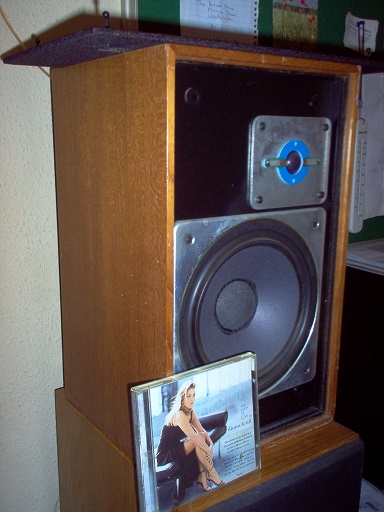
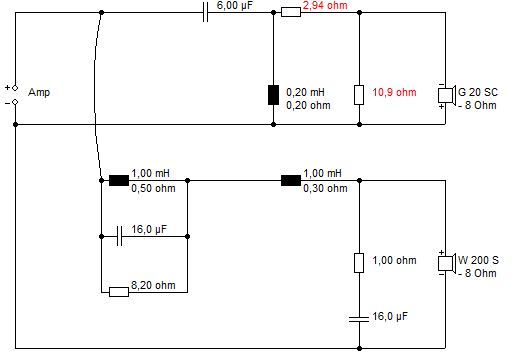
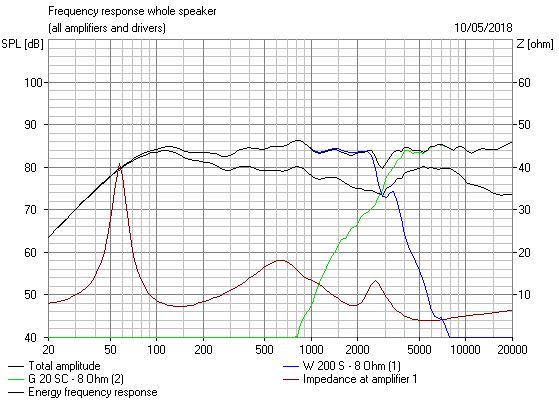
Terrible impedance on that one but actually sounds very good. Might even work with your ribbon.
Second is a Rogers LS5/9 style which uses heavy impedance correction and lets the bass see a very low source impedance:
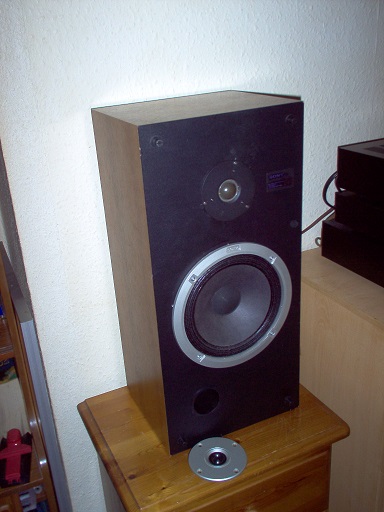
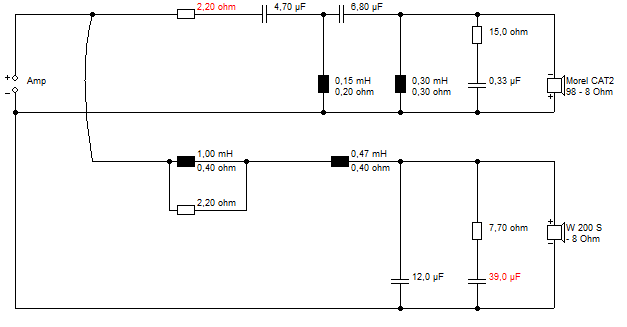

This design is outstanding. I haven't quite decided if I prefer third or fourth order on the tweeter yet. But it's world class sound for a two way. The 39uF and 7.5R is called a Zobel impedance correction, here for a driver around 60 ohms at 10kHz. Your driver might require nearer 15uF and 7.5R. The 89dB tweeter needs to be flat and around 5 ohms DC. But level is adjustable.
The Golden Age of diy! We knew very little, but enough to have a go... how hard could it be?
I must have got lucky, but I had a good time with a pair of new 8" eminence Alpha 8A I found in a junk shop, and 1.5" Audax TW034 tweeters and off-the-shelf 2.5kHz crossovers I bought in the UK equivalent of RadioShack called Maplin. All in old stripped 25L Wharfedale Linton boxes I found in the street. I added an adjustable port stuffed with drinking straws and fiddled with it till it sounded about right.
This speaker of yours sounds worth rescuing. The bass must be OK. Box is on the smallish side, but should be OK.
What it needs is a new 104mm tweeter and a crossover IMO. I could think of half a dozen ways to do the filter, but will confine myself to two tested designs that might be OK.
First is the KEF style, but works with most 8" basses and tweeters:
Terrible impedance on that one but actually sounds very good. Might even work with your ribbon.
Second is a Rogers LS5/9 style which uses heavy impedance correction and lets the bass see a very low source impedance:
This design is outstanding. I haven't quite decided if I prefer third or fourth order on the tweeter yet. But it's world class sound for a two way. The 39uF and 7.5R is called a Zobel impedance correction, here for a driver around 60 ohms at 10kHz. Your driver might require nearer 15uF and 7.5R. The 89dB tweeter needs to be flat and around 5 ohms DC. But level is adjustable.
The 75W L-Pad Controls and the Fiberglass Insulation shown on that page are installed in a pair of my speakers!I loved that old 1988 RadioShack catalogue from Galu!
I have a couple of old Tandy (UK name for Radio Shack) catalogues, but here is where you can view all the RS ones:
Radio Shack Catalogs - General Catalogs
system7: Big thanks, that's the kind of stuff I was looking for. Also, I see the Diana Krall CD in your photo! I use her stuff as test material. New duets with Tony Bennett CD just out, I have not heard it yet. But why did she marry that goofy lookin' Declan McManus fellow? (Saw his first US tour in Long Beach, late 1970's when he was angry and very thin.)
I don't think anything you do to this speaker can make it worse, TBH! 
Can we get more detail on this item? I can't read it properly.
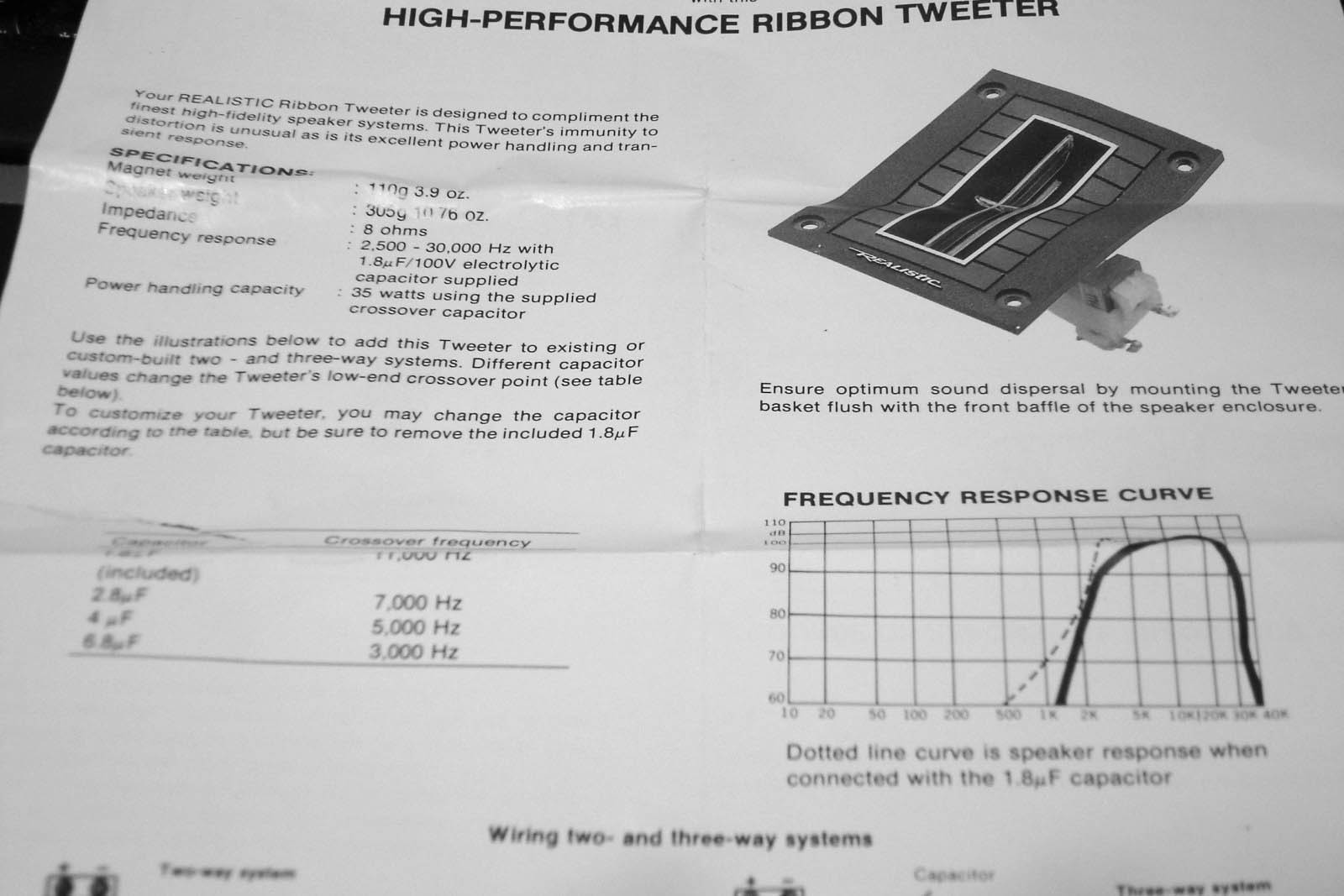
It is usually possible to splice a known tweeter response onto a known woofer response with satisfactory results. Just how it works.
It's going to be 3kHz crossover.
Can we get more detail on this item? I can't read it properly.
It is usually possible to splice a known tweeter response onto a known woofer response with satisfactory results. Just how it works.
It's going to be 3kHz crossover.
Steve,
Tweeter spec sheet photo found on the web, I have not been able to find a better copy of it.
Graph of HD20B25H (from a catalog .pdf) shown below.
Initial tests with just a single 4.2 uF capacitor (about 4,700 Hz) vastly improve the top end on the speaker.
Tweeter spec sheet photo found on the web, I have not been able to find a better copy of it.
Graph of HD20B25H (from a catalog .pdf) shown below.
Initial tests with just a single 4.2 uF capacitor (about 4,700 Hz) vastly improve the top end on the speaker.
Attachments
- Status
- This old topic is closed. If you want to reopen this topic, contact a moderator using the "Report Post" button.
- Home
- Loudspeakers
- Multi-Way
- Ribbon Crossovers: Need help...
